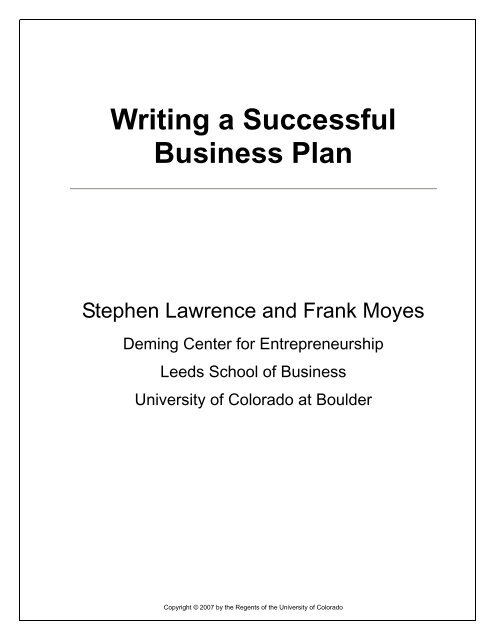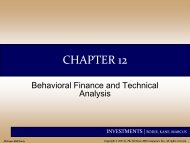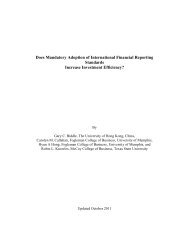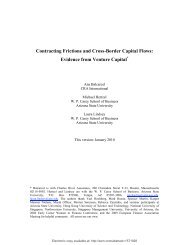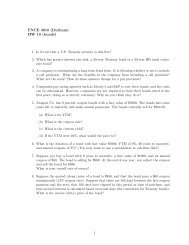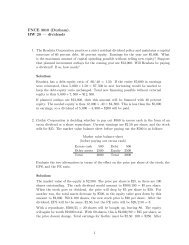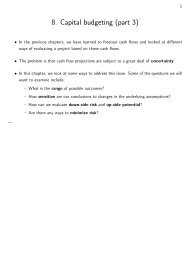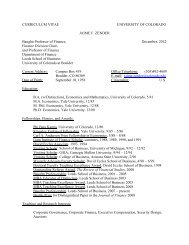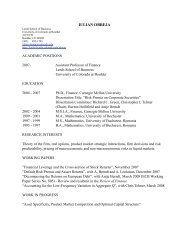Elements of a Successful Business Plan
Elements of a Successful Business Plan
Elements of a Successful Business Plan
Create successful ePaper yourself
Turn your PDF publications into a flip-book with our unique Google optimized e-Paper software.
Writing a <strong>Successful</strong><strong>Business</strong> <strong>Plan</strong>Stephen Lawrence and Frank MoyesDeming Center for EntrepreneurshipLeeds School <strong>of</strong> <strong>Business</strong>University <strong>of</strong> Colorado at BoulderCopyright © 2007 by the Regents <strong>of</strong> the University <strong>of</strong> Colorado
Table <strong>of</strong> ContentsPurpose <strong>of</strong> a <strong>Business</strong> <strong>Plan</strong> .................................................... 2<strong>Elements</strong> <strong>of</strong> a <strong>Successful</strong> <strong>Business</strong> <strong>Plan</strong> ............................... 3Executive Summary ................................................................ 4Company Overview ................................................................. 5Product and Service ................................................................ 6Market and Industry Analysis .................................................. 8Marketing <strong>Plan</strong> ...................................................................... 12Operations <strong>Plan</strong> .................................................................... 20Development <strong>Plan</strong> ................................................................. 23Management <strong>Plan</strong> ................................................................. 24Competitive Advantage ......................................................... 26Financial <strong>Plan</strong> ........................................................................ 28Funding ................................................................................. 33Appendices ........................................................................... 371Writing a <strong>Successful</strong> <strong>Business</strong> <strong>Plan</strong> Copyright © 2007 by The Regents <strong>of</strong> the University <strong>of</strong> Colorado
Purpose <strong>of</strong> a <strong>Business</strong> <strong>Plan</strong>A business plan describes the venture that you will create to exploit a concept. It hastraditionally three primary functions:Action <strong>Plan</strong> A business plan can help to move you to action. You may have beenthinking for years about starting a business or engaging in some venture, but theprocess may seem too daunting, too large and too complicated. A business plan willhelp you to pull apart the pieces <strong>of</strong> starting a business and examine each piece byitself. So instead <strong>of</strong> one large problem, you have a sequence <strong>of</strong> smaller problems.And by solving the small problems, the large problem is automatically solved. Sowriting a business plan can help to move you to action by breaking down a seeminglyinsurmountable task (starting a business) into many smaller, less intimidating tasks.Road Map Once you have started your business, a business plan can be aninvaluable tool to help keep you on track and moving in the direction you want to go.In the hurley-burley <strong>of</strong> daily business, it is very easy to lose sight <strong>of</strong> your objectivesand goals -- a business plan can help to keep you focused. A business plan can alsoserve to help others to understand your vision, including suppliers, customers,employees, friends, and family.Sales Tool A business plan can be used to convince people to become involved withyour business. You may need outside financing to start your business, and abusiness plan is the tool you need to convince investors to come on board. You maywant and need concessions from suppliers or customers -- a business plan can helpyou get them. It also can be used to recruit key employees, directors and advisors.Finally, you may need to convince family members, or even yourself, that your ideaswill bear fruit.Perhaps the most important reason to write a business plan is that it requires you toengage in a rigorous, thoughtful and <strong>of</strong>ten painful process that is essential before youstart a the venture. You must answer hard questions about your venture. Why isthere a need for your product service? Who is you target market? How is yourproduct/service different than your competitor’s? What is your competitiveadvantage? How pr<strong>of</strong>itable is the business and what are the cash flows? How shouldyou fund the business?An added benefit is that by virtue <strong>of</strong> going through this process you will haveestablished a sound basis for verbally communicating the attractiveness <strong>of</strong> yourventure. Your will be able to describe your business in a compelling manner and thento succinctly answer questions from investors is a critical skill. You can do this wellonly when you have made the venture a part <strong>of</strong> your soul. Writing a <strong>Successful</strong><strong>Business</strong> <strong>Plan</strong> will help you do this.2Writing a <strong>Successful</strong> <strong>Business</strong> <strong>Plan</strong> Copyright © 2007 by The Regents <strong>of</strong> the University <strong>of</strong> Colorado
<strong>Elements</strong> <strong>of</strong> a <strong>Successful</strong> <strong>Business</strong> <strong>Plan</strong>Executive Summary (~1 page)Company Overview (~1 page)IntroductionMission StatementHistory and Current StatusObjectivesProduct and Service (~1 page)FeaturesBenefitsProprietary RightsStage <strong>of</strong> DevelopmentMarket and Industry Analysis (~3 pages)Market Size and GrowthTrendsEntry PointChannels <strong>of</strong> DistributionIndustry StructureCompetitive EnvironmentCompetitionOpportunityMarketing <strong>Plan</strong> (~4 pages)Customer ResearchTarget Market StrategyChannelPositioningProduct/Service StrategyPricing StrategyE-commerceCommunication StrategySales StrategyRevenue ModelOperations <strong>Plan</strong> (~2 pages)Operations StrategyScope <strong>of</strong> OperationsOngoing OperationsManagement (~1 page)Company OrganizationManagement TeamCompetitive Advantage (1 page)Sustainable Competitive AdvantageFinancial <strong>Plan</strong> (~3 pages)Financial ProjectionsFinancial SummaryKey AssumptionsRisksFunding (1 page)Funding RequirementsFunding StrategiesOfferingSources and Uses <strong>of</strong> FundsAppendices (15 pages max)RequiredKey financial assumptions5 year Income StatementsBy yearsMonthly & Quarterly5 year Balance Sheet5 year Cash Flow StatementsBy yearsMonthly & QuarterlyBreak-even analysisFinancial CompsCustomer surveys and resultsCompetition MatrixCompetitor product/service matrixResumes <strong>of</strong> founders and principalsOptionalOperations layoutSample web pages, adverts, menus etc.Development <strong>Plan</strong> (~1 page)Development Strategy3Writing a <strong>Successful</strong> <strong>Business</strong> <strong>Plan</strong> Copyright © 2007 by The Regents <strong>of</strong> the University <strong>of</strong> Colorado
Executive SummaryThe Executive Summary <strong>of</strong> a <strong>Business</strong> <strong>Plan</strong> is a one-page distillation <strong>of</strong> yourentire plan, and <strong>of</strong>ten is the last section to be written. Despite the title, it is notwritten for executives, nor is it a summary <strong>of</strong> the plan. Its objective is to capturethe reader’s interest, so that they want to read the entire plan; even better to callyou to arrange a meeting. It should be considered a chance to “sell” the readeron the business opportunity.A first-time reader should be able to read the Summary by itself, and know whatyour plan is all about. The Summary should stand-alone and should not refer toother parts <strong>of</strong> your plan. Remember, most readers will never get any further thanyour Executive Summary, so make it count!The Executive Summary should be a maximum <strong>of</strong> 2 pages. Ideally you should tryto get it all on one page. This is very difficult to do, but being succinct has greatbenefits when trying to capture the attention <strong>of</strong> investors. The summary shouldaddress the following elements <strong>of</strong> the plan:Concept Description Summarize the essence <strong>of</strong> your business.Opportunity Why is this a good opportunity? What evidence do you have tosupport the demand? What is the size <strong>of</strong> your market? What are the criticaltrends? What is the compelling need, i.e. what problems are you solving?Product/Service Describe the product or service. How will you differentiate itfrom the competition? How is the product or service to be produced anddelivered?Value Proposition Who is the target market? What are benefits to the targetmarket?Marketing Strategy What are the key elements <strong>of</strong> your marketing strategy?Competitive Advantage Who is the competition? What is your competitiveadvantage?Management: Who is the management team and why will they make asuccess <strong>of</strong> the venture?Financial How large will the company become, i.e. what revenues will beachieved in year 3 or 4? What is the expected pr<strong>of</strong>itability? When will thecompany breakeven?Funding How much funding is required? What will it be used for? What is the<strong>of</strong>fering? What is the exit strategy?4Writing a <strong>Successful</strong> <strong>Business</strong> <strong>Plan</strong> Copyright © 2007 by The Regents <strong>of</strong> the University <strong>of</strong> Colorado
Company OverviewThe Company Overview is a brief (one page) description <strong>of</strong> the company youhave founded or want to found. Will it be a sole proprietorship, partnership, orcorporation? What are your ambitions for the company? Will it always be a smallcompany, or do you want to grow it into an international giant? Upon reading thissection, the reader should have a good idea <strong>of</strong> where you are and where you aregoing with your company.IntroductionIn the introduction to the Company Overview, answer the following questions in asingle paragraph:What is the name <strong>of</strong> our company?Does our company currently exist, or will it be forming?Where is it located? Where will we grow?How is our company organized (e.g., sole proprietorship, partnership,corporation)?Mission StatementYour mission statement is a short (one sentence to one short paragraph)inspirational statement <strong>of</strong> the vision and goals you have for your company. Toomany mission statements are vacuous exercises in ambiguity, e.g. "employeesare our most valuable asset". Be sure that your mission statement is succinctand content rich, and excites your readers.History and Current StatusBriefly outline the history and current status <strong>of</strong> your company.ObjectivesIn this subsection, spell out the objectives <strong>of</strong> your company in a single paragraph:Where are we going with our company?What are our goals for the company (keep it small, grow it big, franchise it,etc.)?What is our exit strategy for ourselves and for our investors (sell to largercompany, go public, buy out investors, etc.)?5Writing a <strong>Successful</strong> <strong>Business</strong> <strong>Plan</strong> Copyright © 2007 by The Regents <strong>of</strong> the University <strong>of</strong> Colorado
Product and ServiceGuidelines for Preparing This SectionThis section is a detailed description <strong>of</strong> the products and/or services you will beselling. You should not assume that the reader is familiar with yourproduct/service, so be sure to explain it carefully. The use <strong>of</strong> photos, drawingsand renderings are an effective way to describe your <strong>of</strong>fering.Begin to sell your idea here by generating some excitement about yourproduct/service. Be factual, but be enthusiastic. When readers have finishedlearning about your product/service, they should be primed for the marketing,operations and financial strategies <strong>of</strong> your venture.Sources <strong>of</strong> InformationTechnical specification and drawingsPrototypeCompetitor product/service matrixInterviews - talk to experts in the marketplace, including buyers, suppliers,sales representatives, wholesalers, distributors, and retailers.Customer surveysSWOT analysisFeaturesDescribe the product/service features:What are the attributes <strong>of</strong> your product/service, e.g. speed,innovativeness, ease <strong>of</strong> use, etc.?What evidence do you have to support the demand for these features?Is there a range <strong>of</strong> product/services being <strong>of</strong>fered at the beginning <strong>of</strong> theventure? What will be introduced over the next 3 to 5 years?What customer service or tech support will you provide? After salessupport? Training? Delivery? Installation? Repair service? Warranty?Payment terms?What are the prices?For service businesses describe the environment (size, décor and layout,location, etc.). Write a one-paragraph description that evocativelydescribes the experience <strong>of</strong> customers using your service.What is unique about our product/service? What is the benchmark?How will the product/service be produced and delivered? Can you use theproduction process or delivery method to differentiate the <strong>of</strong>fering?How will it be packaged?6Writing a <strong>Successful</strong> <strong>Business</strong> <strong>Plan</strong> Copyright © 2007 by The Regents <strong>of</strong> the University <strong>of</strong> Colorado
BenefitsFor technology products, what are the major technical milestones thatmust be achieved? What is the basis for believing that they areachievable?Describe the benefits to the target market. When considering the benefits,remember that features are not the same as benefits. Your new bicycle may befast and red but these are not benefits. The benefit is that you can wincompetitions and look cool. Think about the impact on the target market’sfeelings (emotions) and pocketbook (financial) (Levinson, Guerrilla Marketing, 3 rdedition, Houghton Mifflin Co).How do the benefits address the needs <strong>of</strong> the target market? Thinkbeyond a generic description <strong>of</strong> benefits, e.g.o Best quality: do you mean appearance, durability, reliability, etc.?o Good service: do you mean on-time delivery, maintenance, techsupport, etc.?o Efficiency: do you mean less time, easier to use, greater output, fewerresources, etc.?o Save time: to do what? It may not always be important to save time.o Convenience, for what?Are the benefits well understood by the target market? What evidence doyou have to support this?Prepare a features and benefits table. For each <strong>of</strong> the important features,describe the corresponding benefit.Proprietary RightsWhat proprietary rights do you have to the product/service? (For many products,there are no proprietary rights and this subsection can be deleted.)Patents, copyrights, trade secrets, non-compete agreements?Other proprietary knowhow or skills?Stage <strong>of</strong> DevelopmentBriefly describe the current status <strong>of</strong> your product or service:Where is the product in its lifecycle (early, growing, mature, declining)?Is it ready for the market, or is it in development?If in development, how far along is it?What obstacles remain?7Writing a <strong>Successful</strong> <strong>Business</strong> <strong>Plan</strong> Copyright © 2007 by The Regents <strong>of</strong> the University <strong>of</strong> Colorado
Market and Industry AnalysisGuidelines for Preparing This SectionThis section dispassionately describes the market you will enter and the industryin which you will compete. You may not even mention your business here, unlessit is already a part <strong>of</strong> the industry. When finished with this section, you and yourreaders should understand the dynamics, problems, and opportunities drivingyour marketplace.Sources <strong>of</strong> informationSecondary research - internet, library, trade associations and journals.Interviews - talk to experts in the marketplace, including buyers, suppliers,sales representatives, wholesalers, distributors, and retailers.Customer surveysSupply chain analysisSamples <strong>of</strong> competitor productsCompetitor brochures, catalogs, specifications, literature, websites,advertising and promotion materialsMarket Size and GrowthA market consists <strong>of</strong> a group <strong>of</strong> customers who are willing to buy products orservices to satisfy a need. For example, people need shoes to wear to work, godancing, play sports and climb mountains. This is the footwear market and each<strong>of</strong> these examples represents a different segment. Within these segments theremay be sub-segments, e.g. in the sports footwear market there are differentsegments for running, cycling, rodeo, etc.Prepare a table(s) that segments your market. Estimate the size (numbers<strong>of</strong> customers, units sold or transactions and dollar value <strong>of</strong> purchases) andgrowth (historic and future) for each segment. Consider the following whensegmenting your market:o Sector: industrial (petroleum, construction, etc.), financial (retailbanks, mortgage lenders, insurance, etc.), government (state,military, homeland security, etc.)o Groups <strong>of</strong> customers: demographics, psychographics, e.g. babyboomers, grandparents, environmentalists, conservatives, etc.o Geography: local regional, national, internationalo Product/service features: speed, performance, fragrance, etc.o Benefits: enhance image, trend setter, weather protection, savemoney, etc.o Prices: premium, lowest cost, standard mark-up, etc.o Distribution channel: retail, internet, door-to-door, etc.8Writing a <strong>Successful</strong> <strong>Business</strong> <strong>Plan</strong> Copyright © 2007 by The Regents <strong>of</strong> the University <strong>of</strong> Colorado
TrendsIdentify the sources.Determine the trends that are driving each <strong>of</strong> the market segments? Howis the market changing? Consider economic, socio-cultural, political/legal,global, environmental, demographic and technological. For example, whatis the impact <strong>of</strong> aging baby boomers, single parent families, ecommerce,etc?Describe both positive and negative developments. Even negative trendscan represent opportunities, e.g. in mature markets a consolidation plancould be viable.Are there customer groups or regions that are not adequately beingserved? Is there a segment where customers are dissatisfied?Entry PointIn this section you will describe the specific market segment that represents thebest point <strong>of</strong> entry. Why is this segment the best one in which to enter themarket? Summarize the size, growth and trends.What future segments are you considering entering? Why?Industry StructureDescribe how the industry is organized.How are goods and services produced and delivered to customers. Whereare they produced? What is the level <strong>of</strong> integration?How do distributors, dealers, VAR’s and systems integrators fit in?A good way to understand the industry is to analyze the supply chain frombeginning to end. This should give you a good understanding <strong>of</strong> thecompetitive forces and where you fit in.Competitive EnvironmentCompetitive Environment - describe the competitive environment in your industry:How do the companies in the marketplace compete: service, quality, price,new product/service introductions, customer support, etc.?What is the degree <strong>of</strong> rivalry among competitors? A highly competitiveindustry means price competition. Most new firms can’t compete on price.What is the response <strong>of</strong> competition to new entries into the market?What problems and concerns do customers have with these competitors?What is the average size <strong>of</strong> the competitors? Is your market placedominated by a few companies that control over 60% <strong>of</strong> the market?9Writing a <strong>Successful</strong> <strong>Business</strong> <strong>Plan</strong> Copyright © 2007 by The Regents <strong>of</strong> the University <strong>of</strong> Colorado
Unless these companies are SOT’s (slow, old and traditional), you shouldnot consider competing directly with them.How do your competitors perceive themselves? Obtain brochures,literature, and advertisements.Barriers to entry - describe the barriers to entry that new companies face:Economies <strong>of</strong> scale: manufacturing, marketing, technologicalCustomer loyalty: well established brands, long established relationshipsAgreements with customers, suppliers, strategic partnersControl <strong>of</strong> the distribution channelSwitching costsCapital requirements: high investmentAccess to distribution channels: exclusive distribution agreements,dominant position <strong>of</strong> competitorsIntellectual property: patents, trade secrets, copyrights, trademarks, knowhowIndustry hostility to new entrants. Will competitors use all means to driveout new companies: pricing, legal, threats, spreading rumors.Government regulations: defense contracts, import restrictionsSocialControl - how much control do you have over:Setting prices: how are prices established in your marketplace (majorcompetitor, industry practice, value added, etc.)? What is the bargainingstrength <strong>of</strong> customers?Costs: can you gain an advantage through technology, process design,resource ownership or access to raw materials, low cost labor, economies<strong>of</strong> scale (difficult for a start-up), and capacity utilization. What is thebargaining strength <strong>of</strong> suppliers?Channels <strong>of</strong> distribution: what channels <strong>of</strong> distribution exist? What accessdo you have to existing channels <strong>of</strong> distribution? Can you create newones? What is the bargaining strength <strong>of</strong> channel companies?CompetitionWrite a paragraph on each competitor that provides a short description <strong>of</strong>what the company does; its position in the industry; strengths andweaknesses. Make sure that you consider all <strong>of</strong> the following sources:Direct: companies that produce same product/service; but, they may havedifferent strategies to compete - price, quality, selection, performance,design, tech support.Indirect: companies that satisfy same need with different product/services.Future: companies that have the capability to enter your market; they mayhave the same customers, but use different technology or channels10Writing a <strong>Successful</strong> <strong>Business</strong> <strong>Plan</strong> Copyright © 2007 by The Regents <strong>of</strong> the University <strong>of</strong> Colorado
To help you write this section, prepare a competition matrix analysis thatcompares your venture with the major competitors. Consider the followingfactors for each competitor. Do not be restricted to these, as each industry willhave its own.Product/Serviceso Product/Service <strong>of</strong>fering – breadth and deptho Quality (define the type quality)o Detailed analysis <strong>of</strong> the key features. Obtain samples <strong>of</strong> thecompetitor’s products, or at the very least, specifications anddrawings. For retail businesses visit the competitor’s locations,observe the environment and how customers interact with thebusiness. For internet businesses evaluate the websites.o Strengths and weaknesseso LocationMarketingo Price range and policyo Target marketo Channels <strong>of</strong> distributiono Marketing/advertising strategyo Sales strategyo Noteworthy marketing techniques (pricing, packaging, promotions,advertising, website, distribution, etc.)o Market perception <strong>of</strong> the company (branding strategy)o Market ShareManagemento Key management (backgrounds and experience)o Strategic alliancesOperationso Manufacturing and locationo Level <strong>of</strong> integrationo Outsourcing <strong>of</strong> production, customer/tech supportFinancialo Company size (revenues, number <strong>of</strong> customers, number <strong>of</strong>employees, etc.)o Financial history (pr<strong>of</strong>itability, cash flow, financial soundness)o Financial resources (ownership, funding, investors, etc.)OpportunityIn this section you should describe succinctly what the opportunity is and why it isattractive. Here is where you need to draw conclusions based on your research,interviews and particularly the customer surveys? This is a key section <strong>of</strong> the11Writing a <strong>Successful</strong> <strong>Business</strong> <strong>Plan</strong> Copyright © 2007 by The Regents <strong>of</strong> the University <strong>of</strong> Colorado
<strong>Plan</strong> because here you must make the case that there is attractive opportunity foryour venture.Why is this a great opportunity? Summarize the size, growth and trends.What is the compelling need? What problem are you solving?What evidence do you have that prove there is a market?Who is the target market?What is unique about your product or service? What are the benefits?What is your competitive advantage?One <strong>of</strong> the most difficult questions that you must answer is what problem are yousolving for your market, i.e. why is there a need for your product/service. Formost new ventures the current product/services in the market are an acceptablesolution. Your challenge is understand the market well enough to be able toexplain why the customer should even care about you and your product/service.12Writing a <strong>Successful</strong> <strong>Business</strong> <strong>Plan</strong> Copyright © 2007 by The Regents <strong>of</strong> the University <strong>of</strong> Colorado
Marketing <strong>Plan</strong>Guidelines for Preparing This SectionThe Marketing <strong>Plan</strong> will make or break the prospects for your venture. A greatidea is meaningless if you cannot find customers. Carefully drafted and logicalfinancial projections are irrelevant if nobody buys your product. In this Marketing<strong>Plan</strong> you must explain to the reader how you will convince the customer to buyyour product/service.Customer ResearchIt is imperative that you do sufficient customer research to convince readers thatcustomers will indeed come flocking to buy your product/service. The primarysource for this information is to talk to your customers. There are many ways toachieve this: showing your product to potential customers to get reactions andsuggestion; conducting focus groups; undertaking walk-up, mailed or emailsurveys; putting up a mock demonstration <strong>of</strong> your concept and solicitingcustomer feedback, and so on. Be creative in finding ways to get honestcustomer input about your product or service.A well designed and conducted survey provides a firm foundation for themarketing plan. This may be the most credible information that you can developto support the viability <strong>of</strong> the venture.Do customers recognize that they have a need for your product orservice?Are the features that you are considering <strong>of</strong> compelling interest tocustomers? If not, what features do they want?What criteria do they use to make a buying decision? Who makes thedecision? Who influences the decision?How much would they pay?Why would they not buy your product/service?Do they really understand the benefits <strong>of</strong> your product/service comparedto all <strong>of</strong> the competitors in the market?Don't inadvertently cook the books here. You are undoubtedly enthused aboutyour concept. Customers will pick up on your enthusiasm and <strong>of</strong>ten reflect it backto you, leading to erroneous conclusions about customer acceptance. So beneutral and factual as you collect data.Describe the conclusions <strong>of</strong> customer surveys. Give a brief summary <strong>of</strong> how theresearch was conducted. A complete description <strong>of</strong> the results and methodologyshould be included in the appendix. If the survey is conducted properly youshould be able to estimate what percent <strong>of</strong> the potential customers would buy13Writing a <strong>Successful</strong> <strong>Business</strong> <strong>Plan</strong> Copyright © 2007 by The Regents <strong>of</strong> the University <strong>of</strong> Colorado
your product/service? This is a very strong basis for determining the market sizeand share.Target Market StrategyHere you should focus on the consumer or user <strong>of</strong> the product/service. Provide apr<strong>of</strong>ile <strong>of</strong> the consumer/user that are you targeting to launch the product/service:Describe the characteristics that define your target consumer/user(demographics, psychographics, type <strong>of</strong> company or industry, etc.).Explain why you chose these particular consumers/users to enter themarket.Describe the unmet needs <strong>of</strong> your target consumers/users that yourproduct /service fulfill or the problems that it solves.When describing your target market strategy it is important to keep in mind:The consumer <strong>of</strong> the product/service may be different than the buyer, e.g.disposable diapers are “consumed” by babies, but are purchased by mom;cad/cam s<strong>of</strong>tware are “used” by design engineers, but may bought by thepurchasing department. Remember that the customer is always the person orentity who pays you the money.Consumer marketo Characterize the consumer according to the following criteria:• demographics (gender, sex, age, race, education, occupation orpr<strong>of</strong>ession, income, location, etc)• Psychographics or life style (attitudes, beliefs, opinions,interests, values, etc.)• Social status (infers certain behavior: middle class valueseducation, family activities, etc.)o What does the consumer think about the product/services currently inthe marketplace? How willing are they to change?o How are buying decisions made? Who makes the decision? Whoinfluences the decision? Are buying decisions based primarily on price,quality, service, convenience, or others? Is there repeat business?o Provide evidence that the customer understands the benefits that yourproduct/service provides and is willing to spend money to buy it.o Provide evidence that the benefits <strong>of</strong> your product/service are sufficientto overcome brand loyalty to the competition and associated switchingcosts?<strong>Business</strong> marketo Describe the organizations that purchase the product/service. Whatindustry or sector, e.g. automotive, state governments, nonpr<strong>of</strong>it? Whatsize, e.g. Fortune 100, number <strong>of</strong> employees, etc.? Where located?14Writing a <strong>Successful</strong> <strong>Business</strong> <strong>Plan</strong> Copyright © 2007 by The Regents <strong>of</strong> the University <strong>of</strong> Colorado
o What does the target market think about the product/services currentlyin the marketplace? How willing are they to change?o How are buying decisions made? Are there different approval levels?Are decisions made centrally or decentralized? At what level is theultimate responsibility for approving expenditures? What is thebudgeting cycle? How long does it take from the first contact to receipt<strong>of</strong> an order? Is there repeat business?o What criteria are used to make buying decisions: lowest price, serviceresponse, tech support, distance from supplier, global reach, ISO9000, design capability, range <strong>of</strong> products, just-in-time, inventorylevels, etc.?o Provide evidence that the customer understands the benefits that yourproduct/service provides and is willing to spend money to buy it.o What is the payment policy? Will organizations pay cash or by creditcard, make a down payment, require credit, etc.? If credit terms arerequired, are discounts for early payment expected, e.g. 2/10, net 30days? What is the actual payment practice?o Are purchases typically made directly from the supplier, throughwholesalers, distributors, retailers, or other?Channel StrategyDescribe how your product/service will reach your customers. Unless you plan tosell directly to consumers there are many different channels that you can use,depending on the industry in which you are competing.Potential channelso Distributors, wholesalers and retailerso Original equipment manufacturers (OEM's), system integrators andvalue added retailers (VAR’s)o E-commerceShould you consider a multi-channel strategy? E-commerce cancomplement other forms <strong>of</strong> distribution.How are buying decisions made? Are there different approval levels? Aredecisions made centrally or decentralized? At what level is the ultimateresponsibility for approving expenditures? What is the budgeting cycle?How long does it take from the first contact to receipt <strong>of</strong> an order?Identify specific companies that will be your channel partners. Describethe discussions that you have had and any commitments that have beennegotiated. .What criteria are used to make buying decisions: lowest price, serviceresponse, tech support, distance from supplier, global reach, ISO 9000,design capability, range <strong>of</strong> products, just-in-time, inventory levels, etc.?What is the payment policy? Will organizations pay cash or by credit card,make a down payment, require credit, etc.? If credit terms are required,15Writing a <strong>Successful</strong> <strong>Business</strong> <strong>Plan</strong> Copyright © 2007 by The Regents <strong>of</strong> the University <strong>of</strong> Colorado
are discounts for early payment expected, e.g. 2/10, net 30 days? What isthe actual payment practice?PositioningPrepare a statement that positions your product/service in the minds <strong>of</strong> the targetconsumer/user relative to the competition. The statement describes the marketyou are considering, identifies the target consumer/user, describes importantfeatures and explains why the he/she/it should care (benefits).To prepare this consider the following:What does the target consumer/user need to believe about your <strong>of</strong>fering?What attributes and benefits <strong>of</strong> your product/service are most persuasivein getting the target consumer/user to act?What is the name <strong>of</strong> the company and why has this been selected?What are the company characteristics (essence <strong>of</strong> personality, tone andmanner)?Explain why you have chosen to position your company in this way. Is there anunmet need in the market? Does this give you an advantage over thecompetition?The positioning strategy should be the basis for all <strong>of</strong> the marketing strategiesthat follow.Product/Service StrategyDescribe how your product has been designed and tailored to meet the needs <strong>of</strong>your target consumer/user and how it will be competitive:What product/service will you <strong>of</strong>fer initially?What future products will you launch? When? To what targetconsumer/users?What specific product/service design and performance characteristicsmeet the needs <strong>of</strong> your consumer/users?How will your product/service be different from your competition?How can you enhance the product or service with a unique process,resources, employee skills, systems, location, strategic partnerships, etc?How will you provide customer service? Training? Repairs and warranty?(This has a major impact on your Operations <strong>Plan</strong>.)What differentiates your product/service in your target consumer/users’minds?What are the strengths <strong>of</strong> your product/service? Weaknesses?16Writing a <strong>Successful</strong> <strong>Business</strong> <strong>Plan</strong> Copyright © 2007 by The Regents <strong>of</strong> the University <strong>of</strong> Colorado
Pricing StrategyExplain your pricing strategy and why it will be effective with your targetconsumer/user.What is your pricing strategy? Why? Consider the following strategies:o Commodity pricingo Set by the marketo Supply and demando Based on competitor(s) priceo Value pricing - how much the consumer/user is willing to pay forvalue receivedo Payback period – depends on impact on company pr<strong>of</strong>ito Industry rule <strong>of</strong> thumb – keystone pricing is common in retailbusinesses and equals purchase cost + 100% markupo Introductory low price to get customers to useo Cost plus + markupo Razor & razor bladeo E-commerce – transaction fee, advertising, intermediarycommission, affiliate commission fee, subscription feeo A la carteList the prices for each <strong>of</strong> the products/services that you <strong>of</strong>fer. What willthe prices be in years 2 to 5?What is the channel pricing, i.e. what discount does each element <strong>of</strong> thechannel receive at each stage. For example, the consumer <strong>of</strong> salmonpays to the retailer $20.00 per pound; the retailer pays the wholesaler$15.00 per pound; the wholesaler pays the salmon company $10.00 perpound.How does your pricing strategy compare with your major competitors?What evidence do you have that your target consumer/user will acceptyour price?E-commerceAll businesses need to consider how they can make use <strong>of</strong> e-commerce.Whether you sell direct to consumers or through distribution channels, e-commerce should be an integral part <strong>of</strong> your marketing strategy. Consider thefollowing:Brand building through affiliate programs and email marketing leadgeneration through search engines and affiliate programsWebsites to provide information, product descriptions and pricing; conducttransactions and enhance brandingCustomer and technical supportExtranets to provide coordination with customers17Writing a <strong>Successful</strong> <strong>Business</strong> <strong>Plan</strong> Copyright © 2007 by The Regents <strong>of</strong> the University <strong>of</strong> Colorado
Communication StrategyIt is critical that you inform your target market about the availability <strong>of</strong> yourproduct/service, and that you continue to communicate the benefits. You shouldconsider the following:Media advertising (TV, radio, newspaper and magazines)Direct response advertising (mail, email, text messaging, infomercials)Outdoor advertising (billboards, posters, cinema, vehicles)Brochures, catalogs, specifications, manualsPoint-<strong>of</strong> purchaseTrade and consumer promotionsSponsorships and eventExhibitions and conferencesPublic relationsE-commerceWhat messages need to be communicated to establish your brand? What is thevisual identity (brand name, logo, tagline, packaging, color palette)?For each strategy you choose prepare a detailed program for at least the first twoyears. For example, if you plan to issue a catalog, how frequently will it bepublished; how many pages; how much will it cost to print and mail? If you planto use media advertising, what newspaper or magazine will you use; what will thead look like; how frequently will it be shown; what is the cost <strong>of</strong> the designing thead and publication.Sales StrategyHow you will sell your product/service is a critical component <strong>of</strong> your success.Remember, nothing happens until the sale is made. Describe how yourproduct/service will be sold:Personal selling? TV infomercials? Direct mail?Who will do the selling? Company sales force? Manufacturer'srepresentatives? Telephone solicitors?How will you generate leads?How will you recruit, train, and compensate the sales force?What sales commission will you pay?How will you support the sales effort (e.g. internal staff, service operations,etc.)?18Writing a <strong>Successful</strong> <strong>Business</strong> <strong>Plan</strong> Copyright © 2007 by The Regents <strong>of</strong> the University <strong>of</strong> Colorado
Revenue ModelPrepare a table that forecasts the revenue <strong>of</strong> your venture over the next 5 years.The key is to consider the drivers <strong>of</strong> your revenue. For each market the factorsare different. For your venture you might consider the following:Market potentialo Size <strong>of</strong> the market in units, number <strong>of</strong> customers or transactionso Growth rateMarket shareo Penetration rate <strong>of</strong> the total market, based on your customer research;or even better <strong>of</strong> a prospect list <strong>of</strong> identified potential customers.o Roll-out strategyProduct and services <strong>of</strong>feredo Range & mixo New products or serviceso ObsolescencePrices for each product line based on your pricing strategyFrequency <strong>of</strong> purchaseo Number <strong>of</strong> purchases per week, monthCapacity utilizationo Hours operatedo TurnsChannel strategyo Distribution channelso Discount19Writing a <strong>Successful</strong> <strong>Business</strong> <strong>Plan</strong> Copyright © 2007 by The Regents <strong>of</strong> the University <strong>of</strong> Colorado
Operations <strong>Plan</strong>Guidelines for Preparing This SectionThe Operations section describes how you will run your business and delivervalue to your customers. Operations is defined as the processes used to deliveryour products and services to the marketplace and can include manufacturing,outsourcing, transportation, logistics, customer and technical service.Be sure that you carefully link the design <strong>of</strong> your operations to your marketingplan. For example, if high quality will be one <strong>of</strong> your competitive advantages inthe marketplace, then design your operations to deliver high quality, not lowcosts. Remember that you will probably have to make trade-<strong>of</strong>fs with youroperations. It is impossible to have the lowest costs, highest quality, best ontimeperformance, and most flexibility in your industry all at the same time. Often,higher quality means higher costs, lower costs means less variety and lessflexibility. Be careful how you make these trade-<strong>of</strong>fs so that you can deliverproducts to the market in accordance with your marketing plan.Sources <strong>of</strong> informationSupply chain analysisInterviews with industry experts, process and production engineers, civilengineersThomas RegistryYellow pagesIndustry trade publicationsIntroductionWrite a brief introduction to the operations section. This can also be a goodplace to include a more colorful and evocative description <strong>of</strong> how you will useoperations to add value for your customers.Operations StrategyDescribe how you will fulfill your marketing strategy using operations:Describe the process for producing and delivering your product/service.How will you use operations to add value for customers in your targetmarket?How will you win in the marketplace on the dimensions <strong>of</strong> cost, quality,timeliness, and flexibility? Which dimensions will you stress and which willyou de-emphasize?20Writing a <strong>Successful</strong> <strong>Business</strong> <strong>Plan</strong> Copyright © 2007 by The Regents <strong>of</strong> the University <strong>of</strong> Colorado
Does your process or way <strong>of</strong> doing business give you a competitiveadvantage e.g. Southwest Airlines or Amazon?Scope <strong>of</strong> OperationsDescribe which operations you will do in-house and which you will subcontract.Why does this make sense for your business? Include details in an appendix, asnecessary. Consider the following:ProductionProduct developmentOrder fulfillmentCustomer serviceWarehouse and shippingTech supportInstallationWarranty service and repairsOngoing OperationsDescribe how your company will operate on an ongoing basis? Include detail inan appendix, as necessary.Identify the key vendors, suppliers, strategic partners, and associates. Whatarrangements have you discussed with them? What price agreements haveyou reached?Based on your sales forecast, estimate how much production or servicecapacity is required over the next five years. This is usually expressed assome rate per hour, day, week, month or year. For example, 100 lightingfixtures per month or 150 meals per day for a restaurant. This is critical toanswering the following questions:o What type <strong>of</strong> facility is required: size, type <strong>of</strong> space (<strong>of</strong>fice, customerservice, development, laboratories, production, warehouse andshipping).o Where will you be located? Why this particular location?o What capital assets do you require? Describe the major items(equipment, vehicles, buildings, fixtures, decorations, computers ands<strong>of</strong>tware, etc.) and how much each will cost. Will you lease orpurchase?Determine your manpower requirements to produce and deliver theproduct/service. What types <strong>of</strong> employees are needed (skilled, technical,supervisory, manual, etc.)? How much will you pay them?Can you use extranets to provide coordination with vendors and strategicpartners?Provide a layout <strong>of</strong> the production or service process. How will yourproduct/service flow through the facility? Put this in the appendix.21Writing a <strong>Successful</strong> <strong>Business</strong> <strong>Plan</strong> Copyright © 2007 by The Regents <strong>of</strong> the University <strong>of</strong> Colorado
Determine how much inventory is required to support the marketing strategy.Express it in terms <strong>of</strong> days or turns. Keep in mind that it is very difficult in theearly stages <strong>of</strong> a new business to operate a just-in-time system. The orderquantities are too small for suppliers to produce economically in smallbatches and deliver to your warehouse every day. Lead times from receipt <strong>of</strong>order can also be quite extended for small quantities.22Writing a <strong>Successful</strong> <strong>Business</strong> <strong>Plan</strong> Copyright © 2007 by The Regents <strong>of</strong> the University <strong>of</strong> Colorado
Development <strong>Plan</strong>Guidelines for Preparing This SectionIn this section, you will outline how you intend to ramp-up your business.Assuming you have a dynamic marketing plan and customers do indeed comeflocking for your product or service, you must be able to deliver it to them. TheDevelopment section is a road map <strong>of</strong> how you are going to get from where youare now to where you want to be in the future. If you are starting a business,what are the key steps that you need to accomplish to get the business up andrunning? If you are expanding a business, what do you need to do to make itgrow? These steps can be as routine as securing retail space, or as critical asapplying for and getting a patent on key technology. Don't go into too muchdetail here. For example, the need to get business cards printed does not belongin a development plan.Sources <strong>of</strong> InformationProduct/Service <strong>Plan</strong>Marketing <strong>Plan</strong>Operations <strong>Plan</strong>Management <strong>Plan</strong>Financial <strong>Plan</strong>Development StrategyDescribe the ten key events that must take place for your venture to succeed.The focus should be over the next 2 to 3 years. For each step indicate thecompletion date. Consider the following:Product and process developmentPrototype developmentIntellectual propertyMarketing strategies, e.g. advertising launch, catalog mailing, websitelaunch, etc.Agreements with key customers, distributors or suppliersStrategic alliancesRoll-out strategies, e.g. by regions, new products, new channelsFacility construction and equipment installationMarket tests or beta tests <strong>of</strong> the product/serviceKey hires, e.g. sales managerFunding23Writing a <strong>Successful</strong> <strong>Business</strong> <strong>Plan</strong> Copyright © 2007 by The Regents <strong>of</strong> the University <strong>of</strong> Colorado
Management <strong>Plan</strong>Guidelines for Preparing This SectionInvestors <strong>of</strong>ten assert that the most important attribute <strong>of</strong> a successful start-up ismanagement. Many claim they will invest in a strong management team with amediocre idea, but will decline to fund a weak management team with a greatidea. The purpose <strong>of</strong> the Management section therefore is to convince thereader that you have a great management team to complement a great businessconcept.This is not the place for modesty or self-deprecation. Be honest, but highlightyour accomplishments and your capabilities while mitigating any obviousshortcomings or weaknesses. For example, if you are young and inexperienced,describe how you will mitigate this by hiring people with the relevant experience;or by recruiting strong board members or advisors. When readers are finishedwith this section, you want them to be confident that your venture is in goodhands and will be competently managed.Sources <strong>of</strong> InformationResumesInterviews with investorsCompany OrganizationDescribe how your company will be organized.Prepare an organization chart.Will you have a board <strong>of</strong> directors? Who will be on it? What will be theirrole?Will you have a board <strong>of</strong> advisors? Who will be on it? What will be theirrole?What is the ownership structure <strong>of</strong> your company? What percent <strong>of</strong> thecompany does each <strong>of</strong> the founders own?Management TeamDescribe the founders and principal managers who will run the venture.Write a short paragraph on each <strong>of</strong> the key managers, describing theirbackground and experience (include resumes in the Appendix).oWhat will be their duties and responsibilities?24Writing a <strong>Successful</strong> <strong>Business</strong> <strong>Plan</strong> Copyright © 2007 by The Regents <strong>of</strong> the University <strong>of</strong> Colorado
o What unique skills do they bring to the venture?o How will they be compensated?Is there a significant “hole” in the team? How do you propose to fill it?Do you plan to have a stock option plan? If so, describe how the plan willbe organized and how large a pool <strong>of</strong> shares is needed.25Writing a <strong>Successful</strong> <strong>Business</strong> <strong>Plan</strong> Copyright © 2007 by The Regents <strong>of</strong> the University <strong>of</strong> Colorado
Competitive AdvantageGuidelines for Preparing This SectionOne <strong>of</strong> the most difficult, but essential, tasks that entrepreneurs face is to explaintheir competitive advantage. This results primarily from an inability orunwillingness to look honestly at the competitive environment. If you haveconducted an industry analysis as suggested in this <strong>Plan</strong> then you should be in agood position to define your competitive advantage.A second reason this is difficult is that by virtue <strong>of</strong> you being successful you willcreate competition. How can you sustain your competitive advantage whenstrong competitors appear?Sources <strong>of</strong> InformationInterviewsIndustry AnalysisCompetitive MatrixSustainable Competitive AdvantageWhen defining your competitive advantage, consider the following:Identify the venture’s resources:o Financial: access to capital (equity & debt), cash reserves, governmentgrants, etc.o Physical assets: plant & equipment, raw materials, location, workingcapital, etc.o Human: social, employee knowledge, experience, accumulatedwisdom, labor cost and skills, etc.o Intangible: patents, trade secrets, know-how, copyrights, databases,etc.o Organizational: culture, contacts, policies, Boards <strong>of</strong> Directors &Advisors, suppliers, service providers, etc.Identify the venture’s capabilities:o World class management (serial entrepreneur)o Well developed, high-quality, accessible contacts that take years tobuildo Sales and marketing experienceo Science or technology expertiseo Supply chain expertiseo Product/service design expertiseo Sales & distribution organization26Writing a <strong>Successful</strong> <strong>Business</strong> <strong>Plan</strong> Copyright © 2007 by The Regents <strong>of</strong> the University <strong>of</strong> Colorado
o Total operational approach (e.g. Dell, Wal-Mart)What barriers can you establish that would restrict entry into <strong>of</strong>competition?o Intellectual property: patents, trade secrets, copyrights, trademarks, etco Switching costs to your target marketo Customer loyaltyo Agreements with customers, suppliers, strategic partnerso Control <strong>of</strong> the distribution channelThe following are potential competitive advantages to consider. All <strong>of</strong> these arenot equal because they either are not sustainable or can be easily duplicated byyour competitors:Strong Competitive Advantageso Intellectual propertyo Agreements with customers or supplierso Long term contractsCredible Competitive Advantageso Control <strong>of</strong> costso Control <strong>of</strong> priceso Locationo World class managemento ExpertiseDifficult Competitive Advantageso First to marketo Development lead timeo Brando Qualityo Serviceo Executiono Relationships27Writing a <strong>Successful</strong> <strong>Business</strong> <strong>Plan</strong> Copyright © 2007 by The Regents <strong>of</strong> the University <strong>of</strong> Colorado
Financial <strong>Plan</strong>Guidelines for Preparing This SectionThe Financial Projections section should be frosting on a cake. You've outlined agreat business concept, demonstrated a real need in the marketplace, shownhow you will execute your ideas, proven that your team is just right to managethe venture, and now you will show how pr<strong>of</strong>itable the venture will be and thecash flow. Note, however, that if your business concept is weak, or there is not amarket, or if your execution is poor, or if your management team is incompetent,then your financial plans are doomed to failure. If you haven't convinced yourreaders by now in the strength <strong>of</strong> your concept, then they won't be convincedwith your financials.Having said this, it is important that you have strong, well-constructed financials.If you can't show that your great concept is going to make money, your readerswill quickly lose interest.Sources <strong>of</strong> informationProduct/Service <strong>Plan</strong>Marketing <strong>Plan</strong>Revenue ModelOperations <strong>Plan</strong>Development <strong>Plan</strong>Management <strong>Plan</strong>Financial CompsFinancial ProjectionsCreate pro forma income statements, balance sheets, and cash-flow projectionsfor 3 to 5 years. As a rule <strong>of</strong> thumb, your financial projections should extend farenough into the future to the point where your business has achieved stableoperations. You may want to consider a Financial Projections Model developedby Frank Moyes and Steve Lawrence specifically for this task developed. Thismay be downloaded from:http://leeds-faculty.colorado.edu/moyes/html/resourcesBe sure that your financial projections are in congruence with the other sections<strong>of</strong> your plan. For example, if you say you will open 3 stores in Year 2 and yourfinancials show you opening 5 stores, readers will quickly lose confidence in yourplan.28Writing a <strong>Successful</strong> <strong>Business</strong> <strong>Plan</strong> Copyright © 2007 by The Regents <strong>of</strong> the University <strong>of</strong> Colorado
Prepare the following projections and place them in the Appendix:Income Statement by years for 5 years; by months for years 1-2 and byquarters for years 3-5Balance Sheet years for 5 yearsCash Flow by years for 5 years; by months for years 1-2 and by quartersfor years 3-5Break-even AnalysisFinancial CompsTo help to validate your financials, compare critical financial measuresfrom your plan to peer companies in your industry (see the FinancialProjections Model, COMPs section). Be able to explain and justifysignificant differences.o Understand where and why there are differences – differences areperfectly acceptable if they can be explained and justified.o If you cannot justify significant differences, adjust your financialstatements to bring them more into line with your industry.AssumptionsWhat assumptions have you made in putting together your financialforecasts? Describe in detail in the Appendix.o Revenue forecasts (prices, volume, discounts, margins)o Cost <strong>of</strong> Revenue (materials, labor, major indirect expenses)o Sales & Marketing expenses (numbers <strong>of</strong> people, key salaries,customer acquisition costs, commissions, exhibitions, advertisingand promotion)o Research & Development expenses (numbers <strong>of</strong> people, keysalaries, subcontract, major expenses)o General & Administrative expenses (numbers <strong>of</strong> people, keysalaries, pr<strong>of</strong>it sharing, rent, major expenses)o Extraordinary income and expenseso Tax rateo Capital Expenditures: prepare a detailed list <strong>of</strong> fixed asset items(equipment, vehicles, buildings, fixtures, decorations, computersand s<strong>of</strong>tware, etc.) and how much each will cost. What are thedepreciation rate assumptions?o Working Capital (accounts receivable, inventory, accounts payable)o Funding (amount and timing <strong>of</strong> equity and debt, interest rate)o Other key assumptions29Writing a <strong>Successful</strong> <strong>Business</strong> <strong>Plan</strong> Copyright © 2007 by The Regents <strong>of</strong> the University <strong>of</strong> Colorado
Financial SummaryPrepare a summary <strong>of</strong> your financial projections to be included in this section <strong>of</strong>the <strong>Plan</strong>. The following format should be utilized:Summary <strong>of</strong> Financial Projections($)Year 1 Year 2 Year 3 Year 4 Year 5Summary FinancialsRevenue 1,000,000 5,250,000 9,750,000 16,250,000 26,000,000Gross Pr<strong>of</strong>it (116,464) 1,723,836 4,066,571 6,936,714 12,002,857EBIT (711,131) (152,064) 768,515 1,591,781 3,803,390EBITDA (667,750) (20,350) 1,012,610 1,965,400 4,313,200Net Earnings (711,131) (212,064) 720,515 1,009,141 2,273,634Net Cash from Operating Activities (810,830) (534,510) 868,850 878,760 1,964,444Capital Expenditures 280,000 500,000 550,000 650,000 750,000Interest Income/(Expense) 0 (60,000) (48,000) (45,000) (14,000)Dividends 0 0 0 0 50,000Cash 409,170 374,660 593,510 822,270 1,786,714Total Equity (211,131) (423,195) 297,319 1,306,460 3,530,094Total Debt 0 500,000 400,000 300,000 200,000GrowthRevenue Growth Rate - CAGR: 425% 86% 67% 60%Net Earnings Growth Rate - CAGR: Nil Nil 40.1% 125.3%RatiosCurrent Ratio 4.2 2.0 2.0 1.9 2.2Debt to Capital (LT Debt + Equity) 0.0 0.3 0.2 0.1 0.0Pr<strong>of</strong>itabilityGross Pr<strong>of</strong>it % -11.6% 32.8% 41.7% 42.7% 46.2%Operating Expenses % 55.0% 35.7% 33.8% 32.9% 31.5%Net Earnings % -71.1% -4.0% 7.4% 6.2% 8.7%ReturnsReturn on Assets -73.9% -9.2% 22.1% 20.0% 27.3%Return on Equity -90.1% -19.7% 40.1% 36.0% 45.2%Return on Capital (LT Debt + Equity) -90.1% -13.4% 32.8% 32.5% 43.5%Key AssumptionsDescribe 2 or 3 key financial drivers <strong>of</strong> the venture. What assumptions have youmade that will determine the financial success <strong>of</strong> the business? Consider thefollowing:What are the key factors in meeting the revenue projections?o Market penetrationo New product introductionso Response rateso Priceso Sales cycleWhat are the key factors in determining gross pr<strong>of</strong>it margins?o Price decisionso Channel discount30Writing a <strong>Successful</strong> <strong>Business</strong> <strong>Plan</strong> Copyright © 2007 by The Regents <strong>of</strong> the University <strong>of</strong> Colorado
Riskso Cost <strong>of</strong> Revenue targets (labor or material costs per unit)o VolumeWhat are the customer acquisition costs? It is very important that youknow this and can explain it to investors. What are the key expenses, e.g.advertising, web developments, promotions, etc?How much will be spent on product and process development? How longwill it take to introduce the product/service into the marketplace?Are there major operations or administrative costs, e.g. lease expenses,patent application, key hire, etc.How much are capital expenditures? What are the key items and howmuch does each cost.What are the working capital assumptions? Accounts Receivable days?Inventory turns? Accounts Payable days.What are the risks to the successful implementation <strong>of</strong> your plans? You mightwonder why you should even mention risks in the plan – won’t investors befrightened <strong>of</strong>f if you point out potential problems? The reality is just the opposite.All businesses face risks and investors want to be assured that you understandwhat they are and, most importantly, what you are going to do to mitigate them.Identify the major risks that your venture faces. Focus on risks that are importantand critical to your business, not the ordinary operating risks faced by anybusiness. The natural tendency is to consider what can go wrong, but equallyimportant is what must go right.Briefly describe each risk and then explain what steps you are going to take toeliminate, or at least minimize, the risk. Consider the following:Marketo Size <strong>of</strong> marketo Competitor’s responseo Long sales cycleo Price that customers are willing to payo Closing windowStrategico Establishing strategic partnershipsOperationalo Large number <strong>of</strong> interrelated componentso Costso Quality levelTechnologyo Will it work?o Patentability31Writing a <strong>Successful</strong> <strong>Business</strong> <strong>Plan</strong> Copyright © 2007 by The Regents <strong>of</strong> the University <strong>of</strong> Colorado
o Time and cost to developmento ScalabilityFinancialo Exchange rateso Interest ratesMacro-economico Volatile industryo Government approvalo New regulations and lawso State <strong>of</strong> the economy32Writing a <strong>Successful</strong> <strong>Business</strong> <strong>Plan</strong> Copyright © 2007 by The Regents <strong>of</strong> the University <strong>of</strong> Colorado
FundingGuidelines for Preparing This SectionIn this section you will determine how much funding you require and how you willuse it. Then, decide what type <strong>of</strong> funding is appropriate for your venture andprepare the <strong>of</strong>fering that you will make to investors or lenders.Sources <strong>of</strong> InformationInterviews with investors and bankersSmall <strong>Business</strong> Valuation Formula Multiples, 2007 edition, BizcompsFinancial CompsFunding RequirementsFrom your cash flow statement, determine the required amount and timing <strong>of</strong>funding needed to execute your plan.Review the Cash Flow projections to determine the amount <strong>of</strong> cashgenerated or required for each year.Review the monthly and quarterly cash flows to determine the impact <strong>of</strong>seasonality or one time expenditures.Determine the amount and timing <strong>of</strong> cash infusions needed to preventcash balances from going negative.Add a cash safety cushion to anticipated cash needs to protect againstunexpected expenses or delayed income. A cushion <strong>of</strong> 20% is a goodstarting point in many situations.Develop a funding strategy that is consistent with your cash needs. Forexample, if you need cash in year one and again early in year two, it maymake sense to seek funding in one lump sum in year one. Alternatively, ifcash is needed in year one and again in year three, it may make bettersense to seek funding in two tranches: the first in year one and a secondin year two.Funding StrategiesDetermine the most appropriate source(s) for the type <strong>of</strong> funding you seek:.Sources <strong>of</strong> equity funding. Equity funding is appropriate for most startupbusinesses with moderate to large cash needs.o Friends and family – suitable for smaller businesses with modest cashneeds, and that will eventually be able to pay dividends or buy backshares. Or, seed stage for high growth ventures.33Writing a <strong>Successful</strong> <strong>Business</strong> <strong>Plan</strong> Copyright © 2007 by The Regents <strong>of</strong> the University <strong>of</strong> Colorado
o Angel investors – suitable for potentially moderately sized businesswith moderate cash needs and good growth potential. Most angelsrequire an exit strategy, but some may look for a cash flow payback.Or, seed stage for high growth ventures.o Venture capital – suitable for potentially large businesses with largecash needs, extraordinary growth potential, and a clear exit strategy(will go public or be acquired).Sources <strong>of</strong> debt financing. Debt may be appropriate for existingbusinesses with a financial track record and assets, or for start-upbusinesses with modest cash needs.o Banks – suitable for businesses with established credit records,ongoing operations, and/or physical assets to use as collateral.o Leases – lease rather than purchase equipment; cash flow must permitregular lease payments.o Small <strong>Business</strong> Administration – government guaranteed loans madeby banks. The criteria are less stringent than a traditional bank loan,but the terms are more expensive.o Credit cards, second mortgages, consumer debt – may be suitablewhen cash requirements are small and the business will quickly beginto through <strong>of</strong>f cash.o Friends and family – may be suitable for small businesses with modestcash needs, and with the ability to make loan payments on a timelybasis.o Many businesses get started using the entrepreneur’s credit cards,personal loans, mortgage on the house or their first born child ascollateral.Sources <strong>of</strong> non-traditional financing. Non-traditional financing may beappropriate when customers or vendors are willing to participate in thebusiness.o Customers:o Companies that see a potential benefit from yourproduct/service may agree pay, e.g. an advance to fund productdevelopment.o Companies may purchase an equity stake in the business tosecure needed product and reliable source <strong>of</strong> supply.o Suppliers:o Vendors who see a potential benefit to their business mayextend special credit terms, e.g. payment in 90 days.o Vendors may furnish equipment and/or supplies in return for anequity stake in the business to secure initial and follow-on sales.o Strategic partners – Established players in a market are always lookingfor companies with interesting technology, product/services, marketsegments, etc. that could benefit their business. An agreement withsuch a company could involve one <strong>of</strong> more <strong>of</strong> the following: equity,licensing, purchasing, selling, joint marketing, co-branding, andmanufacturing. While there are downsides to having a strategic34Writing a <strong>Successful</strong> <strong>Business</strong> <strong>Plan</strong> Copyright © 2007 by The Regents <strong>of</strong> the University <strong>of</strong> Colorado
partner, this is very important avenue for an early stage venture toconsider.o Grants: research grants (SBIR, Defense Dept., Homeland Security,NIH, etc.), state economic development programs, corporations,foundations, etc.o Other creative arrangements – sources <strong>of</strong> non-traditional financing arelimited only by the creativity and ambition <strong>of</strong> the entrepreneur.OfferingThe Offering (or Funding Request) is where you make your pitch for money.Equity: describe the type <strong>of</strong> security being <strong>of</strong>fered (common, preferred,warrants, etc) to the investor and what share <strong>of</strong> your company they willreceive for a specified investment.o To calculate how much <strong>of</strong> the company to <strong>of</strong>fer you will need toplace a value on the business. It is important that you persuadeinvestors that the deal you are <strong>of</strong>fering is fair to them and issupported by the facts. There are many approaches that can beused; you should investigate which method(s) are appropriate foryour industry. From your interviews with industry experts andsecondary research find out what valuations are being negotiatedfor companies <strong>of</strong> your size, stage and industry.o A valuation model is included in the Financial Projections Model.o What is your preferred exit strategy? How can investors realize areturn on their investment? Go public? Sell out? Operate and grow?What is your exit for investors if the business does not develop asyou hope?o Remember that everything is open to negotiation.Debt: If you are seeking a loan, then you need to indicate to the lender theterm <strong>of</strong> the loan, repayment schedule, interest rate, collateral, and how itwill be repaid.In either case, it is important that you clearly spell out the key terms <strong>of</strong> theproposal and sell the advantages to the investor/lender, and show howthey can get a satisfactory return.Sources and Uses <strong>of</strong> FundsPrepare a Sources and Uses statement.Sources <strong>of</strong> Funds: determine the amount, source and timing <strong>of</strong> fundingthat you have chosen for the venture: equity, debt, or non-traditionalfinancing35Writing a <strong>Successful</strong> <strong>Business</strong> <strong>Plan</strong> Copyright © 2007 by The Regents <strong>of</strong> the University <strong>of</strong> Colorado
Uses <strong>of</strong> Funds: based on the projection <strong>of</strong> the funds required and timing,describe how the funds would be used. For example:o Product or process design and development; web designo Marketing actions, e.g. major advertising campaign, catalog, grandopeningo Intellectual property protectiono Key hireso Capital expenditures, e.g. new machine, major renovation, informationsystemo Working capital36Writing a <strong>Successful</strong> <strong>Business</strong> <strong>Plan</strong> Copyright © 2007 by The Regents <strong>of</strong> the University <strong>of</strong> Colorado
AppendicesThe appendices are where you should collect all <strong>of</strong> the documentation thatsupports your business plan. Include those documents that are required(financial projections), those that are helpful (results <strong>of</strong> marketing studies), andthose that assist in selling your idea (purchase orders or letters <strong>of</strong> intent frompotential customers). Don't include lots <strong>of</strong> tangential information such asnewspaper clippings or tables <strong>of</strong> data unless they serve to bolster your plan. Oneway to deal with information that is voluminous and/or lengthy (such as a largemarket research study) is to summarize it, and note in the plan that the completedocument is available upon request.Required itemsFinancial Statementso 5 year Income Statement• Annual projections• Monthly and Quarterly projectionso 5 year Balance Sheeto 5 year Cash Flow Statements• Annual projections• Monthly and Quarterly projectionso Break-even analysiso Financial assumptionsCustomer survey methodology and resultsCompetition matrixCompetitor product/service matrixManagement resumesOptional itemsDevelopment timelineOperations layoutSample menus, web pages, advertisements, etc.Anything else that will help to illuminate and/or sell your plan37Writing a <strong>Successful</strong> <strong>Business</strong> <strong>Plan</strong> Copyright © 2007 by The Regents <strong>of</strong> the University <strong>of</strong> Colorado


